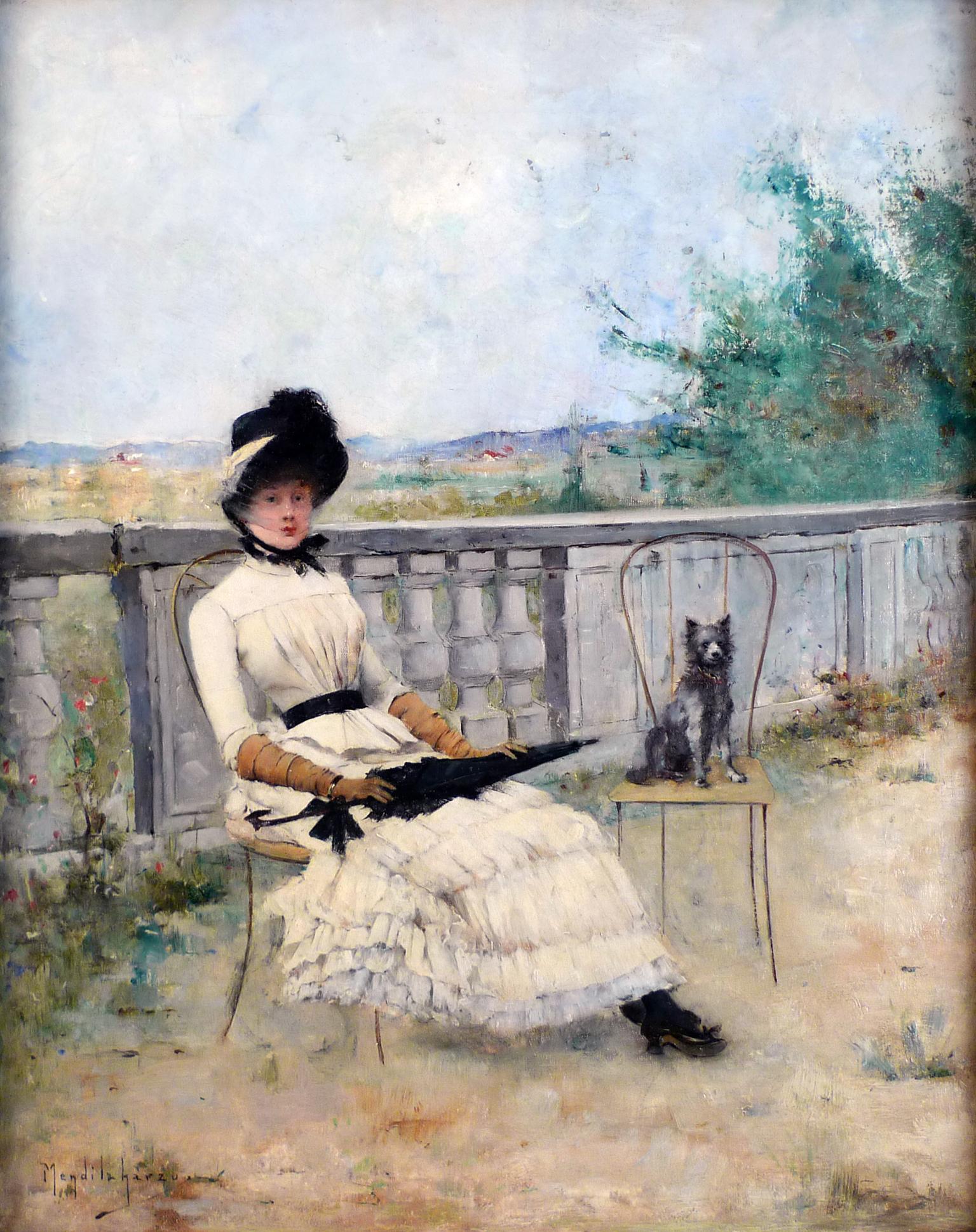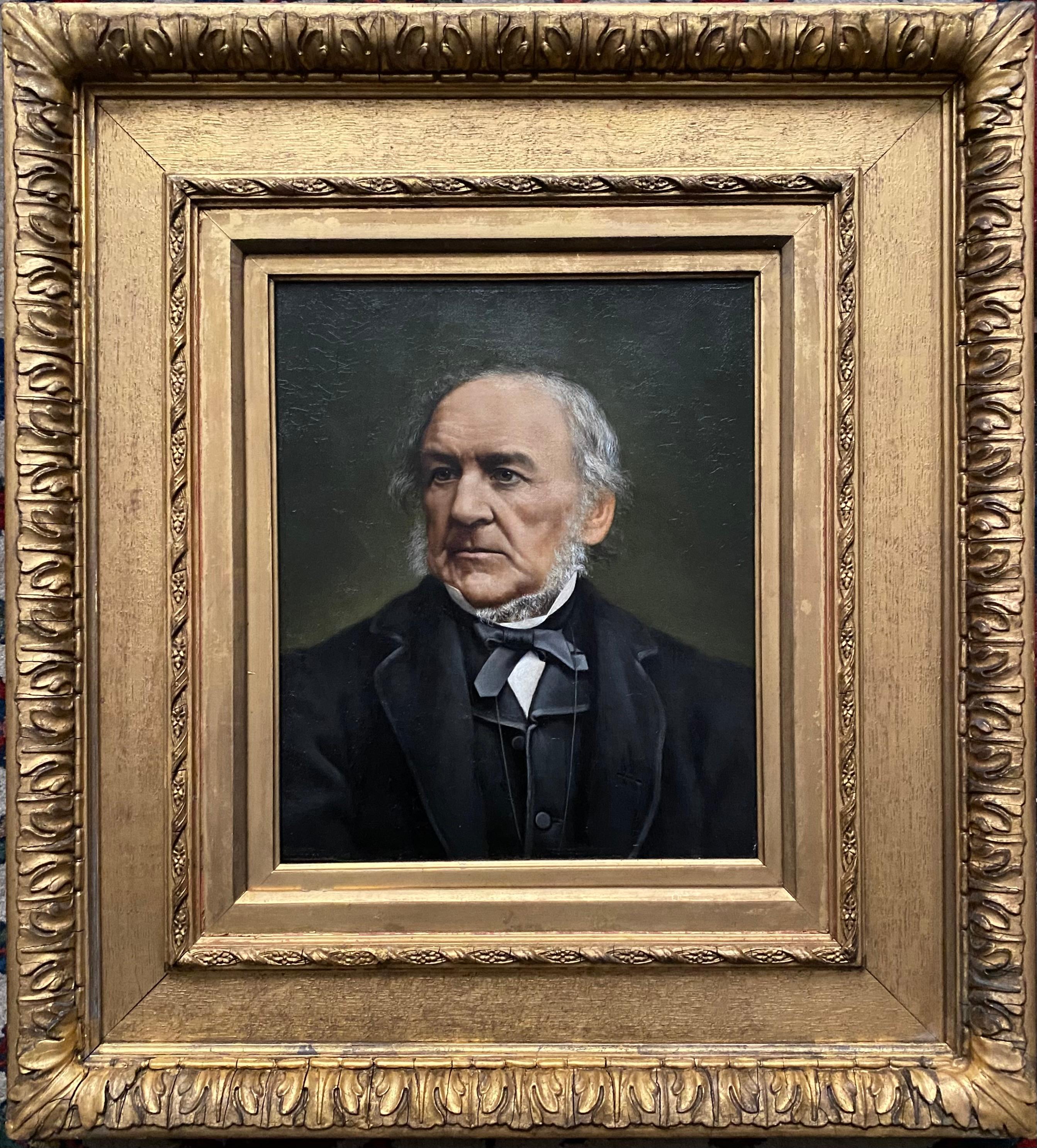Items Similar to Portrait of a Naval Officer, English School 18th Century
Want more images or videos?
Request additional images or videos from the seller
1 of 6
18th Century English SchoolPortrait of a Naval Officer, English School 18th Century
About the Item
Oil on canvas
Image size: 29 1/2 x 24 inches (75 x 61 cm)
Period gilt frame
This is a notable half length portrait of a navel officer, holding a telescope. He stands wearing a blue grey coat over a lighter waist coast and a powdered wig with buckles (rolled curls) that is worn en queue. A seascape can be seen beyond him with a bright clear sky in the background.
Prior to the 1740s, Royal Navy officers and sailors had no established uniforms, although many of the officer class typically wore gentleman’s clothing with wigs to denote their social status. The early Royal Navy also had only three clearly established shipboard ranks: Captain, Lieutenant and Master. This simplicity of rank had its origins as far back as the Middle Ages.
Uniform regulations for naval officers were first issued by Lord Anson in 1748, and was in response to officers wishing for an established uniform pertaining to their service. Officer uniforms were at first divided into a ‘best uniform’, consisting of an embroidered blue coat with white facings worn unbuttoned with white breeches and stockings, as well as a ‘working rig’ which was a simpler, less embroidered uniform for day-to-day use.
- Creator:18th Century English School (English)
- Dimensions:Height: 29.5 in (74.93 cm)Width: 24 in (60.96 cm)
- More Editions & Sizes:1 of 1Price: $9,224
- Medium:
- Movement & Style:
- Period:
- Condition:
- Gallery Location:London, GB
- Reference Number:1stDibs: LU52412163372
About the Seller
5.0
Vetted Seller
These experienced sellers undergo a comprehensive evaluation by our team of in-house experts.
Established in 2007
1stDibs seller since 2014
64 sales on 1stDibs
Typical response time: 2 hours
- ShippingRetrieving quote...Ships From: London, United Kingdom
- Return PolicyA return for this item may be initiated within 14 days of delivery.
More From This SellerView All
- Portrait of William Ewart GladstoneLocated in London, GBOil on canvas Image size: 10 x 30 1/4 inches (25.5 x 77 cm) Original gilt Watts frame This is a head and shoulders portrait of William Ewart Gladstone painted after a photograph tak...Category
19th Century Naturalistic Portrait Paintings
MaterialsCanvas, Oil
- Portrait of John HoppnerBy Sir John HoppnerLocated in London, GBAfter Sir John Hoppner 1758 - 1810 Self Portrait Oil on canvas Image size: 18 1/2 x 21 1/2 inches (47 x 55 cm) Original gilt Carlotta frame This wonderful painting is after John Ho...Category
Mid-19th Century Naturalistic Portrait Paintings
MaterialsCanvas, Oil
- The Distraction, Late 19th Century Oil Painting, OrientalistLocated in London, GBWalter Charles Horsley 1855 – 1921 The Distraction Oil on canvas, signed lower left Image size: 25 x 20 1/2 inches (63.5 x 52 cm) Orientalist ha...Category
Late 19th Century Portrait Paintings
MaterialsOil, Canvas
- Portrait of a King's MessengerBy Charles PhilipsLocated in London, GBCharles Philips 1703 - 1747 Portrait of a King's Messenger Oil on canvas Image size: 35 ¾ x 28 inches Original gilt frame King's Messenger The job of a King's Messenger was that of a diplomatic courier, hand-carrying important and secret documents around the world. Some say that the history of the sovereigns' messengers goes back to 1199, but the first known messenger was John Norman, who in 1485 earned 4d (1½ pence) per day for carrying the state papers of Richard III. The silver greyhound on the messenger's badge dates back to Charles II. In 1660, during his exile at Breda, Netherlands, Charles II issued a declaration of amnesty to all those who had opposed him and his father. He used messengers to make his intentions known. In answer to the messenger's question "How will they know me?", Charles reached forward to a silver bowl on the table in front of him. This bowl, with four decorative greyhounds standing proud above the rim, was well known to all courtiers. Charles broke off a greyhound and gave it to the messenger as a guarantee that the message came from him. From that date, the King's Messenger always wore a silver greyhound around his neck. Later, dating from George II or III, a badge with the Royal Arms in enamel, with the greyhound suspended beneath, was worn. A George III example of the King's Messenger Badge, pre 1800, sold for over £30,000 pounds some years ago. The silver greyhounds were minted for each new reign, except the brief one of King Edward VIII. The sovereign's messengers were originally controlled by the Lord Chamberlain, being Messengers of the Great Chamber. When the Foreign Office was created in 1782, the messengers remained common to the three Secretaries of State. Charles Philips was an English artist known for painting a number of portraits and conversation pieces for noble and Royal patrons in the mid-eighteenth century. Philips was baptised in the combined parish of St Mildred, Poultry with St Mary...Category
18th Century Portrait Paintings
MaterialsOil, Canvas
- Portrait of Miss Tonks, Signed and dated 19th Century OilLocated in London, GBOil on canvas, signed and dated lower right 1882 Image size: 36 x 29 inches (92 x 74 cm) Gilt Watts frame LITERATURE The Life and Work of Frank Holl, Ada ...Category
19th Century Victorian Portrait Paintings
MaterialsOil, Canvas
- Portrait of a GentlemanLocated in London, GBOil on canvas Image size: 17 x 23 1/2 inches (43 x 60 cm) Contemporary William Kent hand made frameCategory
18th Century Portrait Paintings
MaterialsCanvas, Oil
You May Also Like
- "Reflection", 19th Centuty oil oncanvas by Argentinian painter G. MendilaharzuLocated in Madrid, ESGRACIANO MENDILAHARZU Argentinian, 1857 - 1894 "REFLECTION" signed "Mendilaharzu" (lower left) oil on canvas 18-1/4 X 15 inches (46 X 38 cm.) framed: 27-1/4 X 23-3/4 inches (69 X 60...Category
1890s Naturalistic Portrait Paintings
MaterialsCanvas, Oil
- Large portrait painting of Edward VII after FildesBy Charles WillisLocated in London, GBThis exceptional oil painting has been attributed to Charles Willis, who was an accomplished early 20th Century British artist. Willis based this work on a famous State portrait of King Edward VII, completed in 1902 by Sir Samuel Luke Fildes...Category
20th Century Naturalistic Portrait Paintings
MaterialsCanvas, Oil
- Naturalistic Cowboy Portrait of Jim Derrick Roidosa Downs Carlsbad, New MexicoLocated in Houston, TXNaturalistic portrait of Jim Derrick by the artist Lou Benesch. The portrait features a central figure clad in a cowboy hat, nice work shirt, and a gold bracelet leaning against a po...Category
20th Century Naturalistic Portrait Paintings
MaterialsOil, Canvas
- The blue bow: a little boy with tousled hair naturalistic portrait oil paintingLocated in Norwich, GBThis sweet little boy sits quietly like a well brought up child, but you can see in his eyes how much he likes to run and play. In this sensitive portrait painted in circa 1860 by Fé...Category
1860s Naturalistic Figurative Paintings
MaterialsCanvas, Oil
- Figurative Yellow and Blue-Toned Realistic Impressionist Portrait of a BoyLocated in Houston, TXYellow and blue-toned abstract impressionist portrait of a boy by Danish artist Hans Christian Bärenholdt. Signed by the artist at the bottom right. Hung in a gold carved frame. Dim...Category
1940s Naturalistic Portrait Paintings
MaterialsCanvas, Oil
- Figurative Neutral-Toned Realistic Impressionist Portrait of a Man in a SuitLocated in Houston, TXNeutral toned abstract impressionist portrait of a man wearing a suit by Danish artist Hans Christian Bärenholdt. Signed and dated by the artist at the bottom right. Currently hung i...Category
1940s Naturalistic Portrait Paintings
MaterialsCanvas, Oil
Recently Viewed
View AllMore Ways To Browse
18th Or 19th Century Etchings
2 Century
Antique English
18th Century Early
Antique In English
English Period
18th Century Framed
Paintings Of The 18th Century
English Images
18th Century Blue
English Royal
Early 18th Century English
18th Oil
18th Oil Painting
18th Century Canvas
English Masters
English Art School
Oil Canvas 18th Century



